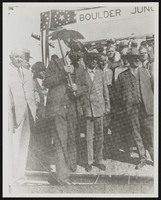Search the Special Collections and Archives Portal
Search Results

Photograph of six men at the signing of the Boulder Dam Bill, December 21, 1928
Date
Archival Collection
Description
Image

Dr. Ray Lyman Wilbur, United States Secretary of the Interior: photographic print
Date
Archival Collection
Description
Image
Las Vegas Convention and Visitors Authority Records
Identifier
Abstract
The Las Vegas Convention and Visitor Authority Records (1973-2007) contain memorandums written by Rossi Rallenkotter, the Vice President of the Authority's marketing division to Las Vegas hotel sales and travel directors. The memorandums provide monthly visitor statistics. The collection also includes information on riverboat gambling legislation and the capacities of function/meeting rooms in various Las Vegas hotels. Also included are LVCVA marketing plans and bulletins.
Archival Collection
Pacific Engineering and Production Company of Nevada (PEPCON) Disaster Collection of News Articles
Identifier
Abstract
The Pacific Engineering and Production Company of Nevada (PEPCON) Disaster Collection of News Articles (1988-1992) consists of articles from Las Vegas and other state and regional newspapers about the PEPCON plant explosion that took place in May of 1988. Also included are United Press International press releases from October to December, 1988.
Archival Collection
Wayne Cronister Photograph Collection
Identifier
Abstract
The Wayne Cronister Photograph Collection depicts towns in Southern Nevada from 1905 to 1950. The photographs primarily depict Fremont Street in Las Vegas, Nevada and the construction of the Hoover (Boulder) Dam on the Colorado River. The photographs also include the Union Pacific Railroad Depot in Las Vegas, Nevada, the abandoned town of Rhyolite, Nevada, and a mining camp in El Dorado Canyon.
Archival Collection
Murl Emery Photograph Collection
Identifier
Abstract
The Murl Emery Photograph Collection consists of seventeen black-and-white photographic reprints of ferries and recreational activities near Searchlight, Nevada on the Colorado River taken from approximately 1910 to 1946, and reprinted from approximately 1970 to 2004.
Archival Collection
William Fulton Papers
Identifier
Abstract
The William Fulton Papers (1993-1996) contains Fulton's research files used in writing his book,
Archival Collection
Dr. Howard Zellhoefer Collection of Artwork
Identifier
Abstract
The Dr. Howard Zellhoefer Collection of Artwork contains three paintings collected by Dr. Howard William Zellhoefer. Two paintings are by K. Nakamine of landscapes in Okinawa, Japan from 1949, and the third painting is a 1962 Ferdinand Burgdorffof a desert landscape, possibly Mojave Desert, California.
Archival Collection
Thomas J. Osborne Photograph Collection
Identifier
Abstract
The Thomas J. Osborne Photograph Collection (approximately 1890-1930) consists of black-and-white photographic prints, negatives, and slides. Images depict the family of Thomas J. Osborne, his law office, the family home, and views of the town of Pioche, Nevada and surrounding areas. Several images depict local mines and unidentified mine workers.
Archival Collection
Geneva Stark Merwin Photograph Collection
Identifier
Abstract
The Geneva Stark Merwin Photograph Collection features photographic prints and negatives of locations throughout Pahrump, Nevada between 1941 and 1942. Primary locations include a Pahrump school and Pahrump Ranch, as well as locations in local fields and mountains. The photographs capture candid scenes of people walking to school and feeding animals.
Archival Collection
